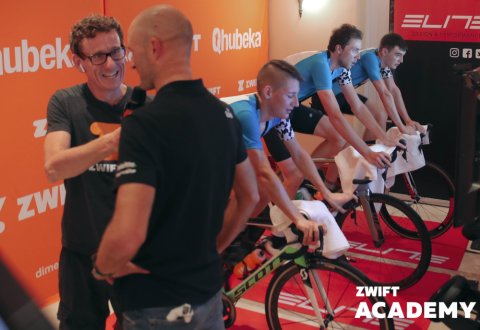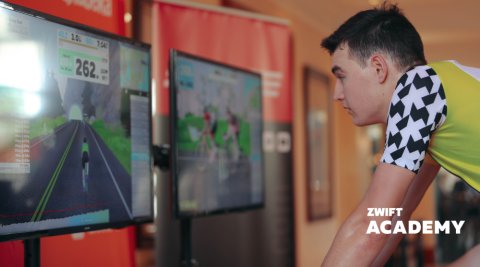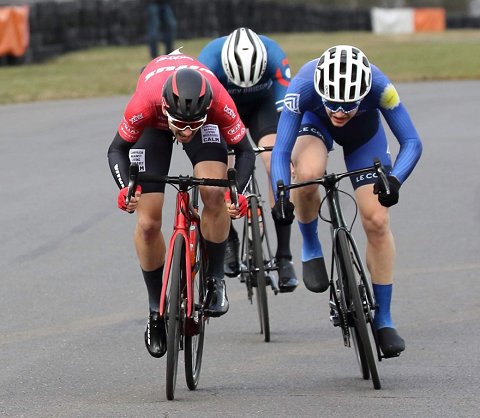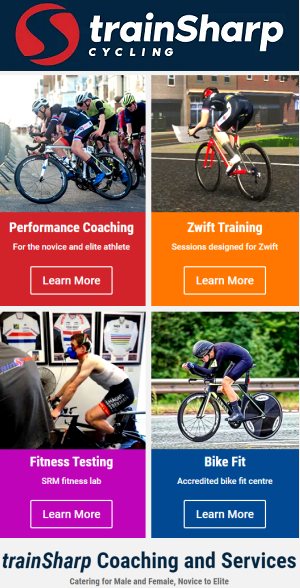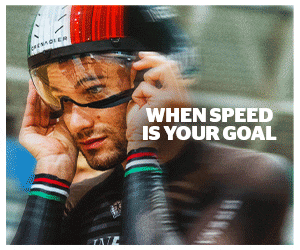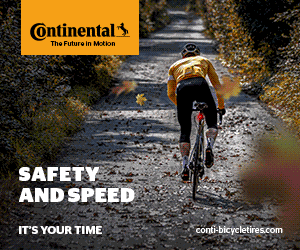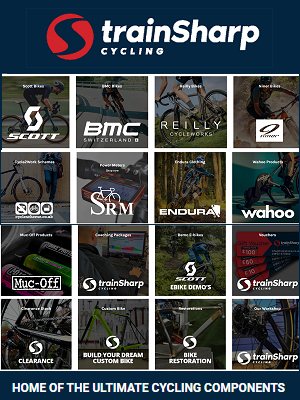Today’s E-Racing lockdown Q&A is with Oliver Peckover (ActiveEdge Race Team) who was a 2018 Zwift academy finalist in Cape Town with Team Dimension Data
E-Racing Lockdown Q&A: Oliver Peckover
Q: What are the essentials to have if you want to have a go at E-Racing?
Oliver: At the lower end of getting into Zwift racing, any turbo trainer will do (a rear wheel-on trainer is okay, but power is very inaccurate! The best route to go is getting a direct drive trainer (take the rear wheel out).
These can vary in price, anywhere from £400 up to the £1200 range and possibly even further than that if you want to get proper serious like getting a specific smart bike from the likes of Wattbike, Wahoo and Tacx. You will also need something to run the programme of choice on, such as a laptop but you can also use a tablet or a phone but seeing small numbers on the screen can be hard.
For the majority of racing on Zwift for example, it is fine to not use a heart rate monitor, but in the bigger events, a heart rate strap is mandatory, or you will get a nice DQ from the event! Following on from the big events on Zwift, it is now being introduced that all competitors have to do a ‘dual-recording’. This means that competitors have to record the power from two different power sources, such as the turbo and a set of power cranks or pedals.
Q: What is the best estimate as to what a set up for e-racing would cost, minus the bike?
Oliver: At the lower end, you can get into E-racing for not much expense at all, picking up a basic trainer could set you back less than £100, paired with your phone which most of us have anyway.
At the other end of the scale however, to take part in the big events which tend to be invite only so you have to prove yourself beforehand, it could cost upwards of £1,000, with a high end turbo and some even getting a dedicated laptop to ensure top quality gameplay.
Q: Why do you have to know how much you weigh?
Oliver: You need to know your weight because it all goes into a calculation in order to work out the w/kg (watts/kg), which is then translated into the speed which you do in game. People weigh themselves in different ways and with different amounts of kit on, the majority however just wear bibs, jersey and socks as a general rule of thumb.
Q: What is the best way to keep cool with E-racing?
Oliver: Fans and the windows open! It’s also wise to have a headband on, and a towel (or 2) to hand to mop up the sweat before you make puddle or get your nice shiny bike covered in sweat!
Q: What is the typical distance/length of a race online?
Oliver: Races can last anywhere between 15 minutes and 2 hours! Generally however, races are over within 15 and 60 minutes, depending on the course and the distance of the race.
Q: What is the ideal warm up for an E-race?
Oliver: It’s entirely up to you, and what works best for you. Some work well with a short warm up, where some like to get in an hour of pedalling before the race. I personally, go with around 20 minutes, a couple of minutes easy, a ramped effort taking me all the way to race pace, a couple of minutes easy, then ending with a couple of short, sharp efforts.
… continued after advert
Q: Can you slipstream in a peloton in an E-race?
Oliver: Yes, and it’s by the far the hardest and most important skill to learn. Just like riding on the road, you can save a significant amount of energy, by spending time in the wheels out of the virtual wind.
Q: How hard is the effort in an E-race?
Oliver: In E-racing, the initial effort off the line, is like that of a tight twisty crit race on the road, real fast, fighting for position. This is the easiest bit to be dropped in, losing the wheel at the start, and you can say goodbye to your chances of regaining contact.
During the race on the flats, it’s a crucial skill to learn how much you can afford to ease off in the bunch without getting dropped, and it’s also the hardest technique to explain to someone.
In the bunch, you can comfortably sit in the bunch whilst maintaining 15-30w less than the guys pushing the wind on the front and if you start to drift a bit far back, then put in a small effort in order to hold the position.
On the downhills in a large group, it is possible to even freewheel, depending on the descent, at a minimum, you can back right off for a couple of pedal strokes on even the shortest of descents, getting a little micro rest can feel like a huge relief!
Q: Is E-racing like an E-game, and does it have different categories or levels?
Oliver: Absolutely, it does have different levels. Cycling is an all-inclusive sport where everyone can take part, so it’s only right that platforms such as Zwift, have different categories. These categories are based on your FTP w/kg(functional threshold power watts/kg), or, the max watts per kilo you can maintain for an hour. For example, there are the following categories:
D: 1-2.4w/kg
C: 2.5-3.2w/kg
B: 3.2-4.0 w/kg
A: 4.0- 5.0 w/kg
Simply pick the category in which you fall into and race against people of a similar capability.
Q: What is it about E-racing that is hard for pros even to get up to speed on straight away?
Oliver: The biggest reasons why we see the pros not winning everything in E-racing, is it because it takes a very different skillset in order to perform. For example, at first, you may think it is all about putting out the max power you can, where it’s more on the tactics you implement in order to get a good result, just like real life racing.
Another aspect in which takes a lot of practise, is just sprinting on a turbo. It takes a very different technique with the bike locked in a static position, where riders on the road may use a bit of a swing in the bike to produce more power.
Q: Are there normal mass group rides on there like races (like sportives) or is it more steady?
Oliver: On Zwift, there is a huge amount of events every day, ranging from very steady social rides, to high intensity group workouts, where the whole group take part in the same efforts (powers adjusted for everyone to their own capabilities), whilst also sticking together in a big group. Then there are the races, from 15, to 120 minute races over varying terrains, from desert flats, to climbing a virtual Alpe, Alpe Du Zwift.
Q: Can riders find training sessions on Zwift to get them started with E-training?
Oliver: Yes, there are hundreds of workouts! Ranging from short sessions, all the way to a couple of hours of hard efforts, there’s something for everyone, with more being added all the time. As well as all of these individual training sessions, there are also training plans lasting between 3 and 12 weeks for those wanting to stick to a routine and see the progression as the plan goes on.
Q: Is E-racing as much fun in a different way to normal racing?
Oliver: Absolutely! It gets a bit addictive as it’s something to do with the satisfaction of smashing out a hard race and getting a good workout from it. With so many events on the Zwift calendar, there’s at least a couple of races every hour of the day to choose from! With E-racing having the huge convenience of being in your own home, there’s a lot less prep that goes into getting ready for a race, no travelling around, no muddy piles of kit to sort after the race, which is obviously the worse part about racing, cleaning everything after racing!
Thank you to Ollie Peckover, Rider for Active Edge RT for that excellent Q&A – stay safe and take care out there.
2017 Zwift academy semi finalist
2018 Zwift academy finalist in Cape Town with Team Dimension Data
Cycle Division’s Shop
Send your results as well as club, team & event news here
Other Results on VeloUK (including reports containing results)
- RR Result: PB Performance U23 Nat Series RR
- Features, Reports, Results
- TT Result: Barrow Central Wheelers 21m TT
- TT Result: Dursley Road Club 6.8m TT
- TT Result: Farnborough & Camberley CC 10m TT
- TT Result: East Sussex CA 10m TT
- TT Result: Kings Lynn CC 10m TT
- Youth Result: North West Youth League 2
- Crit Result: Ennerdale 2024 Season openers 3
- Crit Result: Carlisle Some Enchanted Evenings 1
- Crit Result: Hub Velo/6AM Cycling Spring Crit Series
- Crit Result: Oxfordshire Road Race League (Abingdon)
- RR Result: Radnorshire Road Race
- Crit Result: Full Gas Spring Cup #1
- Events: 18th Rutland-Melton CiCLE Classic Route
- Events: Nigel Harrop Memorial Road Race
- TT Result: VTTA East Midlands 10m TT
- TT Result: East Sussex CA 25m TT
- TT Result: VTTA Kent 30m Time Trial
- TT Result: Shaftesbury CC 25m TT
- TT Result: CTT Classic Series 3
- TT Result: Diss & District CC 25m TT
- TT Result: Icknield RC 20m TT
- TT Result: Royal Albert CC 10m TT
- TT Result: Southport CC 15m TT
- Crit Result: Milton Keynes Development Races
- This weekend: 18th CiCLE Classic UCI 1.2
- The Dave Peck Memorial: British Women’s Team Cup 2
- BMCR RESULT: National A/B RR and Echelon Cycles Stallard races
- RR Result: Proper Northern Road Races (Oakenclough)
- RR Result: Drummond Trophy
- Crit Result: Thruxton Tuesday Series 2
- Crit Result: CDPP Sport Crit Series 1
- Crit Result: SACA Salt Ayre Series 1
- Crit Result: Portsmouth Evening Circuits 4
- Crit Result: Rowe & King Maindy 1
- Q&A: Charlie Abraham (Lee Valley Youth Junior Cycling Team)
- Events: SSSCCRRL Road Race League
- Youth Result: Isle of Man Youth League
- Youth Result: Lawford Youth Series (Curborough) #2
- Crit Result: Full Gas Summer Circuit Series #2
Other News on VeloUK
- Events: 18th Rutland-Melton CiCLE Classic Route
- Events: Nigel Harrop Memorial Road Race
- This weekend: 18th CiCLE Classic UCI 1.2
- Events: SSSCCRRL Road Race League
- Ribble Collective: Ride More in ’24
- Startlist: The Drummond Trophy
- EVENTS: Proper Northern Road Races – Round 2 Oakenclough
- Events: Dave Peck Memorial
- News: Women’s Tour of Britain
- Startlist: PB Performance Espoirs Road Race
- East Cleveland Classic: Saint Piran Team
- News: New kit for Ribble Rebellion Riders
- Events: Halesowen Friday Track Nights
- Team News: Ribble Rebellion off to the USA
- News: Pedal Club Lunch (March)
- Rider News: Winning start for Billy Ladle
- News: CiCLE Classic 2024
- Startlist: Stars of the SW Men’s U23 RR
- Startlist: Danum Trophy 2024 (Nat B)
- Startlists: London Dynamo Road Races
- Startlist: La Fleche Waltonne Road Races (BMCR)
- Meet Ribble HoloRider
- Startlists: East Cleveland Classic 2024
- Former Winners: Lincoln Grand Prix
- Chris Lawless Joins Saint Piran Team
- Paracycling Track Worlds Day 4
- Para CyclingWorlds Final Day
- Startlist: National Youth Circuit Series Rd 1
- Report/Result: Azets Spring Classic
- Startlists: RCR Fat Creations Road Races
- Startlist: Capernwray Road Race (March 31)
- Team Report: Fensham Howes MAS Design Junior Team
- Team Report: CiCLE Classic Junior Men
- RIDER REPORTS – Zoe Parker (Solihull CC)
- GB News: Two World Titles for GB at Para Worlds
- Team News: Alba Development Road Team
- News: British Road Champs Return to NE
- THIS WEEKEND: Peaks Two Day is Back!
- News: Laura Kenny Retires
- Team News: Lee Valley Youth Cycling Team







